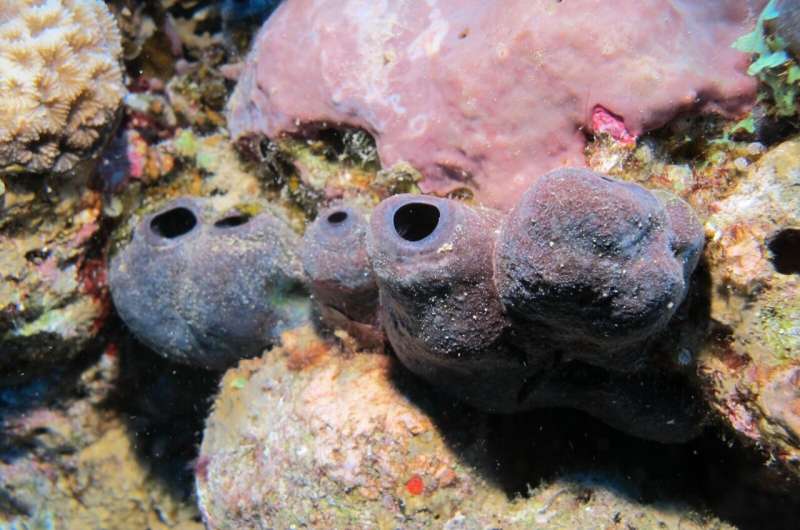
The research sponge Theonella conica in its natural habitat (Red Sea). Photo credit: Shani Shoham
A new study from Tel Aviv University has found that sponges in the Gulf of Eilat have developed an original method of keeping predators away. The researchers found that the sponges contain an unprecedented concentration of the highly toxic mineral molybdenum (Mo). In addition, they identified the bacterium that allows sponges to store such high concentrations of this precious metal and deciphered the symbiosis between the two organisms.
The study was led by PhD student Shani Shoham and Prof. Micha Ilan from the Zoology Department of TAU. The article was published in the journal Scientific advances.
The researchers explain that sponges are the oldest multicellular organisms known to science. They live in marine environments and play an important role in the Earth’s carbon, nitrogen and silicon cycles.
A sponge can process and filter 50,000 times its body weight in seawater every day. As these enormous amounts of water flow through it, it can accumulate various trace elements – and scientists are trying to understand how it copes with toxic levels of substances such as arsenic and molybdenum.
PhD student Shani Shoham says: “20 to 30 years ago, researchers from our laboratory collected samples of a rare sponge called Theonella conica from the coral reef of Zanzibar in the Indian Ocean and found high concentrations of molybdenum in it. Molybdenum is a trace element that is important for metabolism in the cells of all animals, including humans, and is widely used in industry.
“In my research, I wanted to check whether such high concentrations also occur in this species of sponge in the Gulf of Eilat, where it grows at depths of more than 27 meters. When I found the sponge and analyzed its composition, I found that it contained more molybdenum than any other organism on Earth: 46,793 micrograms per gram of dry weight.”
Shoham adds: “Like all trace elements, molybdenum is toxic when its concentration is higher than its water solubility. However, we must not forget that a sponge is essentially a hollow mass of cells without organs or tissues. In Theonella conica in particular, up to 40% of the body volume consists of a microbial community – bacteria, viruses and fungi that live in symbiosis with the sponge.
“One of the most common bacteria, Entotheonella sp., serves as a ‘detoxification organ’ for the accumulation of metals in the body of its sponge host. The bacteria hoard more and more molybdenum and convert it from its toxic soluble state into a mineral. We are not sure why they do this. Perhaps the molybdenum protects the sponge by proclaiming, ‘I’m toxic! Don’t eat me!’ and in return for this service, the sponge does not eat the bacteria and serves as their host.”
Molybdenum is in high demand, especially for alloys (for example, to make high-strength steel), but according to Shoham, it would be virtually impossible to extract it from sponges. Shoham explains: “The concentration is very high, but converted to weight, we could only extract a few grams from each sponge, and the sponge itself is relatively rare. Sponges are farmed in marine agriculture, mainly for the pharmaceutical industry, but this is quite a demanding undertaking. Sponges are very delicate creatures that need special conditions.
“On the other hand, future research should focus on the ability of the bacterium Entotheonella sp. to accumulate toxic metals. Several years ago, our laboratory discovered enormous concentrations of other toxic metals, arsenic (As) and barium (Ba), in a close relative of Theonella conica, called Theonella swinhoei, which is widespread in the Gulf of Eilat.
“In this case too, Entotheonella was found to be mainly responsible for storing the metals and transforming them into minerals, thus neutralizing their toxicity. Further research on these bacteria may prove useful to treat water sources contaminated with arsenic, a serious threat that directly affects the health of 200 million people worldwide.”
Further information:
Shani Shoham et al, Out of the blue: hyperaccumulation of molybdenum in the Indo-Pacific sponge Theonella conica, Scientific advances (2024). DOI: 10.1126/sciadv.adn3923
Provided by Tel Aviv University
Quote: Study shows sponges’ symbiosis with bacteria helps them store toxic molybdenum to keep predators away (August 20, 2024), accessed August 20, 2024 from https://phys.org/news/2024-08-sponges-symbiosis-bacteria-toxic-molybdenum.html
This document is subject to copyright. Except for the purposes of private study or research, no part of it may be reproduced without written permission. The contents are for information purposes only.

